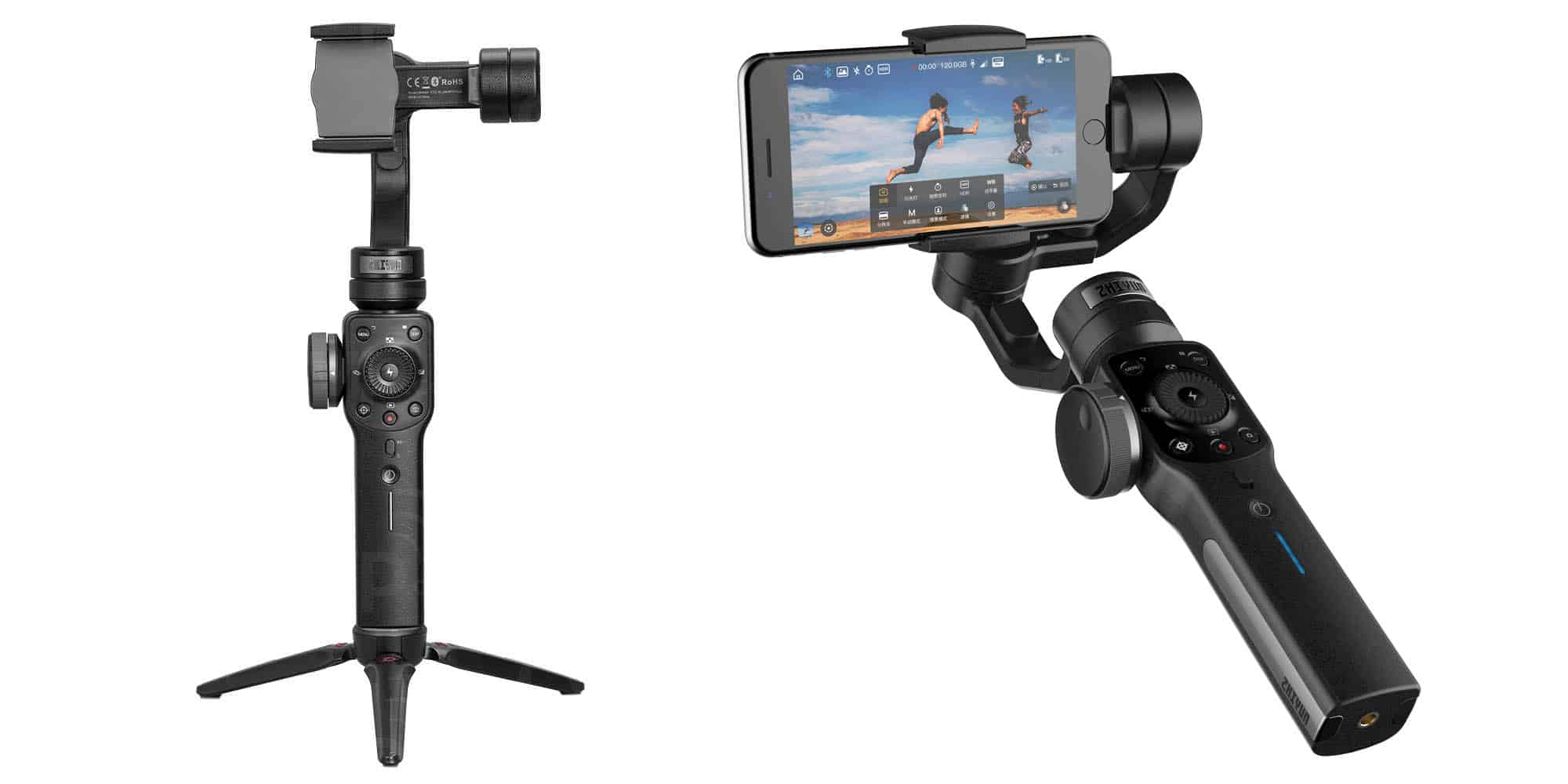Zhiyun are one of the biggest handheld gimbal producers on the market and its not surprising that the new Zhiyun Smooth 4 is already being touted as the DJI Osmo Mobile 2 killer. With a similar price point and packing in more features than the Osmo Mobile 2, it certainly seems like the Zhiyun Smooth 4 has a good shot at becoming the smartphone gimbal to have today.
In this review of the Zhiyun Smooth 4 gimbal stabilizer I’ll be looking at exactly what it does, share my first impressions, go through its various controls and shooting modes before finishing with my verdict. It’s a slightly longer review so please bear with me!
What’s It For?
The latest iPhones and Androids are now packing powerful cameras that take incredible photos and are capable of recording crisp 4K video at 60fps.
It’s therefore no wonder that many people are ditching their bulky DSLR cameras and video recorders and doing everything using their smartphone.
If you’re beginning to take shooting video on your phone seriously, you’ll no doubt have some experience dealing with camera shake. Even if your phone features fantastic optical image stabilization (OIS), the fact is if you’re moving around and filming, camera shake will be noticeable.
The Zhiyun Smooth 4 is a 3-axis gimbal stabilizer that is designed to almost completely eliminate camera shake. By mounting your phone on the gimbal, three brushless motors will rotate three pivots in 3-axes—pan, tilt and roll. These rotations are opposite to camera shake, thereby keeping your camera steady.
I go into more detail about the tech in this article, but hopefully you have a clear understanding of why you might want to film with a motorized gimbal like the Zhiyun Smooth 4.
First Impressions
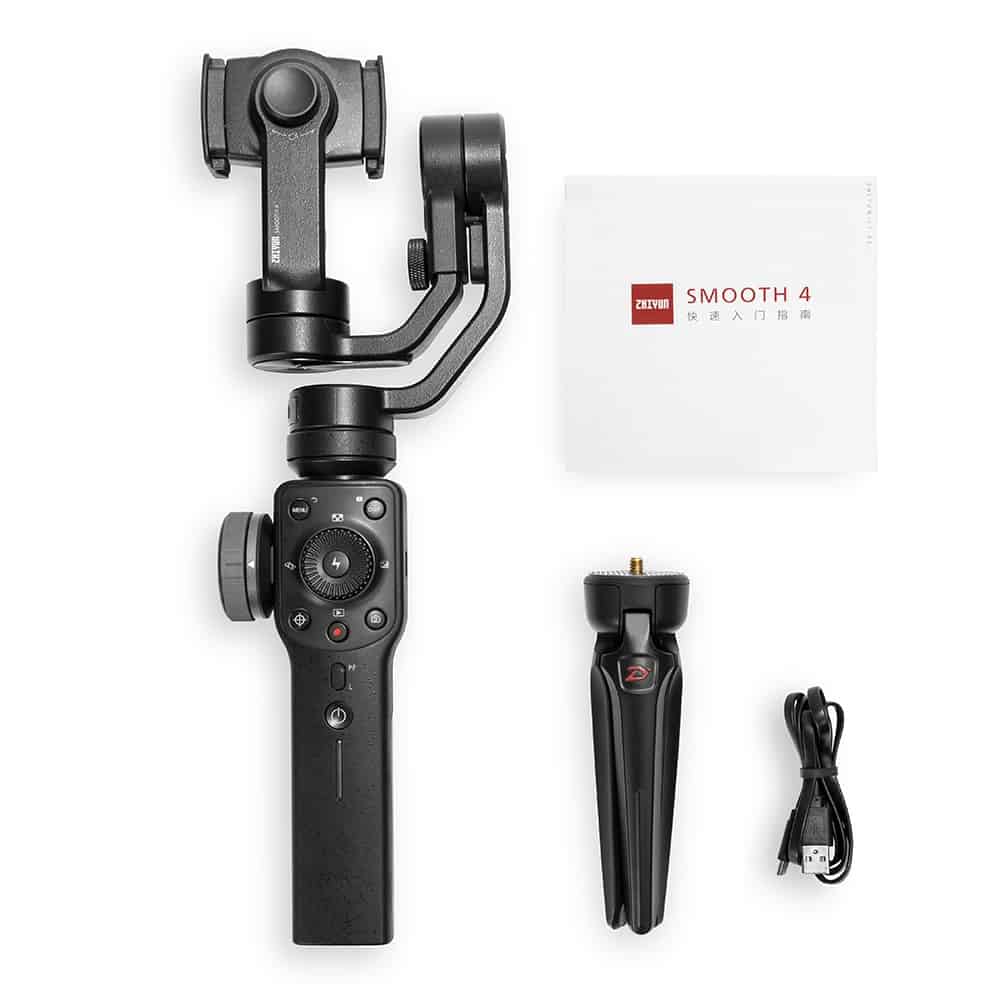
The Zhiyun Smooth 4 comes packaged in a somewhat unremarkable grey styrofoam box that is lightweight and sturdy.
The only accessories included are a charging cable and small but functional tripod.
The charging cable is USB-C type and its nice to see Zhiyun adopting the latest technologies unlike the majority of gimbals (including the DJI Osmo Mobile 2) which still feature a Micro USB port. You can finally say goodbye to carrying around two USB cables.
Right off the bat, the Zhiyun Smooth 4 looks bigger and more advanced than other gimbals. Whereas the DJI Osmo Mobile 2 is compact and only includes the bare essential controls, the Smooth 4 has numerous buttons and dials to play with.
A nice feature is that the gimbal’s arm will lock itself into position when you line it up with the gimbal’s head. That means you won’t have the arm and clamp freely swinging about when it’s not being used.
It also has a stylish blue LED battery indicator and sleek metal Zhiyun strip at the top which make it one of the more aesthetically pleasing gimbals around. However, the Zhiyun Smooth 4’s plastic construction means its build quality is nothing particularly special.
- 👍👍【Filmic Pro】The official APP for Smooth 4 is called ZY play....
- 👍👍【Control Panel】Integrated control panel design,Focus Pull &...
- ✅✅【MUST KNOW】Balance the gimbal before use: Slide the smartphoone...
- 👍👍【PhoneGo Mode】PhoneGo Mode for Instant Scene Transition
Compatibility
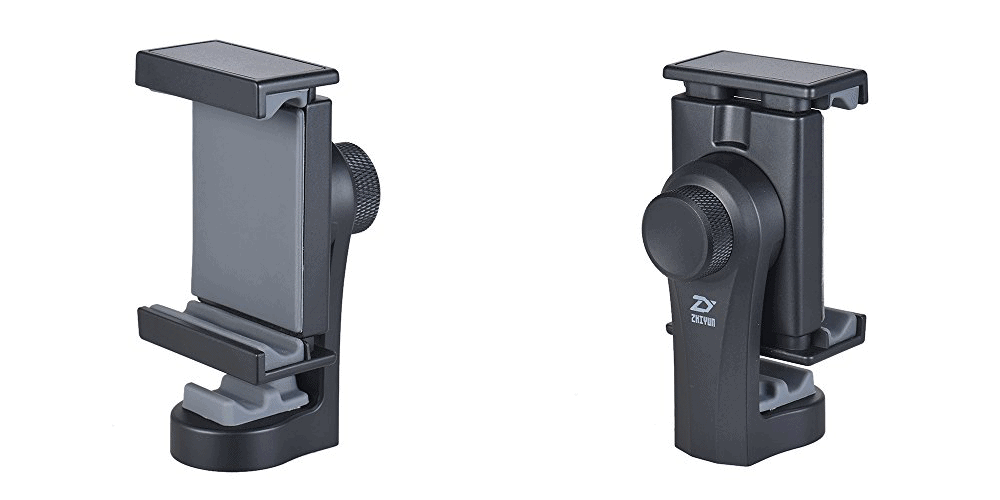
I found it incredibly easy to mount the various phones I tested the Smooth 4 with. Its adjustable spring loaded clamp means you simply need to open up the clamp and it will then grip the phone into place when you let go.
With a maximum supported payload of 210g, the Zhiyun Smooth 4 is compatible with almost all smartphones, including bigger ones like the Samsung Note 9. However, the 208g iPhone XS Max pushed the Smooth 4 to its limits and caused some balancing issues.
When you first setup the Zhiyun Smooth 4 with a new device, you will want to loosen the screw at the back of the clamp and slide the clamp along the rails into a position that best balances your device when the gimbal is held upright. The gimbal will electronically level your device when switched on, but it will overwork the gimbal’s motors and impact battery life if you don’t balance it well in the beginning.
Is the Smooth 4 compatible with GoPros and other action cameras?
The Zhiyun Smooth 4 unofficially supports GoPros. I had no problem fitting my GoPro in the clamp and recording with it. The setup is far from ideal, however. This is because many of the Smooth 4’s buttons and other functions are rendered unusable.
Controlling the Zhiyun Smooth 4
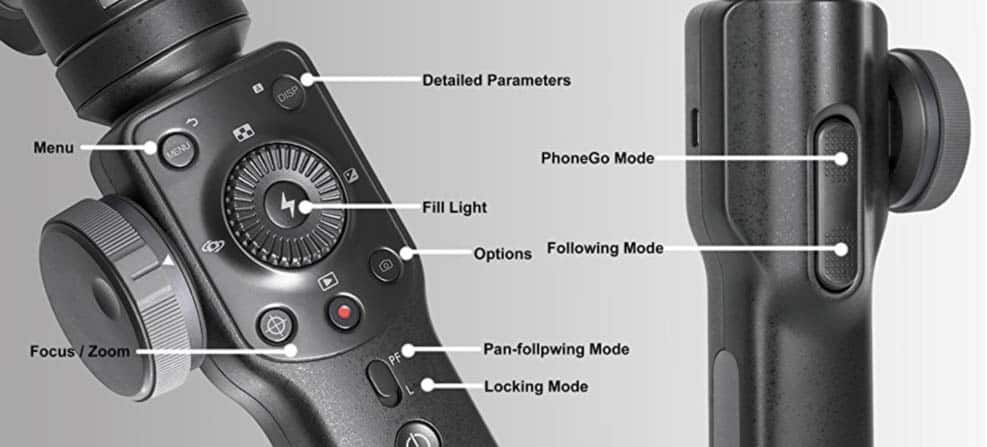
Unlike the DJI Osmo Mobile 2, the Zhiyun Smooth 4 is loaded with various controls on the hand grip. This means you rarely have to resort to touching your phone’s display to change settings like the exposure level or resolution.
The dial on the left of the hand grip can be used to adjust the focus and digital zoom. Most gimbals don’t let you physically adjust the focus, so this feature will tempt those more creative filmmakers. The digital zoom was very smooth and didn’t have the increments you often notice with other gimbals featuring a physical digital zoom control.
The button in the center of the controls will turn on the camera’s flash when pressed, again providing the user with more convenience. Although I didn’t end up using it much, there are definitely situations where you want to switch on the light while recording.
Being able to access menus, zoom in and out, turn on the flash and so forth using controls on the gimbal saves a lot of time and hassle.
However, there is one big caveat—most of these functions only work when you’re using the ZY Play app. The ZY Play app is decent and its current revision has solved various issues it used to have with Android users. However, I personally don’t like so many of the gimbals features being tied to the app.
Missing Joystick
Many gimbals feature a joystick which can be used to electronically pan and tilt the camera. The DJI Osmo Mobile 2 features this, and Zhiyun’s very own older Smooth Q also does.
However, DSLR gimbals and the high end Movi Cinema Robot for smartphones don’t feature pan/tilt joysticks.
So is it a big deal or not?
Personally, I consider having a joystick to be a bit of a gimmick that has somehow become a trend for smartphone gimbals. In my opinion, panning and tilting with your own hand is part of the fun. Using these joysticks in the past have also been very clunky experiences.
Whatever your stance on joysticks may be, just be aware that the Smooth 4 doesn’t have one.
Shooting Modes
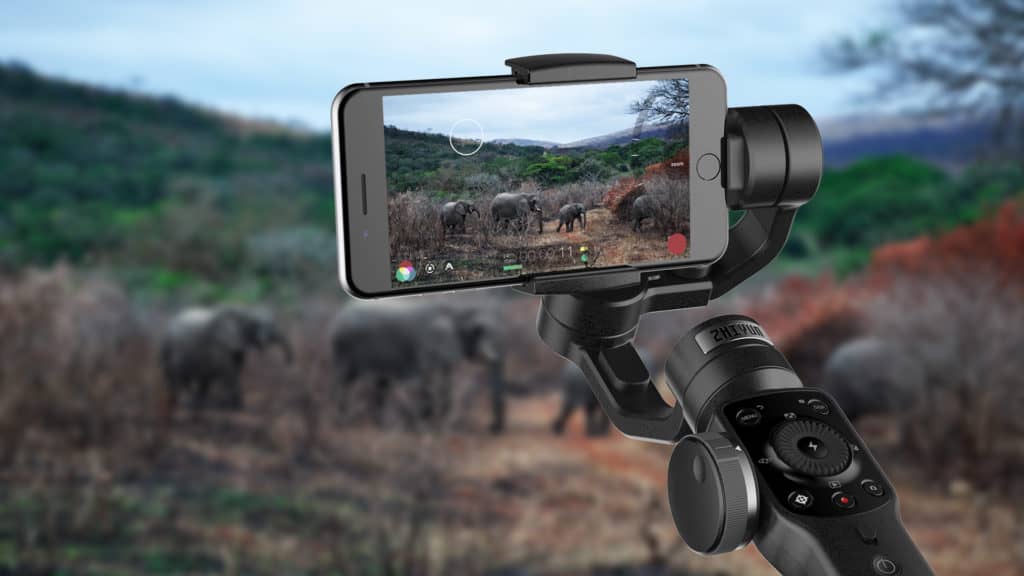
The 3-axis Zhiyun Smooth 4 has three basic gimbal shooting modes.
The first is pan and follow, which keeps the horizon level. In other words, the gimbal will follow your movements left and right (in the pan axis) but counteract any movements which point the camera up or down.
The second mode is following mode which means it will follow your movements in the pan and tilt axis. However, it will lock the roll axis, meaning if the camera rolls to the left or right, the gimbal will counteract those movements to keep the camera parallel to the ground.
The last mode is locked mode where all 3 axes are locked. This means the Zhiyun Smooth 4 will hold your camera’s orientation and stay focused on its target. This is useful when recording what’s going on at the stage during a concert or when you mount it on a vehicle.
PhoneGo Mode
A neat little feature of the Smooth 4 is the “PhoneGo” mode that can be activated by pressing the trigger button at the back of the grip. This essentially makes the gimbal more responsive to movements by increasing the motor speed. It’s nice when you want to capture the quick changes of direction in your recording.
Photo Modes
Using the ZY Play app makes it easy to take many kinds of photo.
- Single shot photos (very simple thanks to a dedicated snap button on the gimbal)
- Panorama shots (180-degree panoramas and 3×3 panoramas)
- Timelapses and Motion Timelapses
- Vertigo Effect
The vertigo effect mode is a photography effect that I haven’t seen any other smartphone gimbals feature. It’s a nice little camera effect, although I didn’t find myself playing with it very often.
FiLMiC Pro App – A supported third-party app
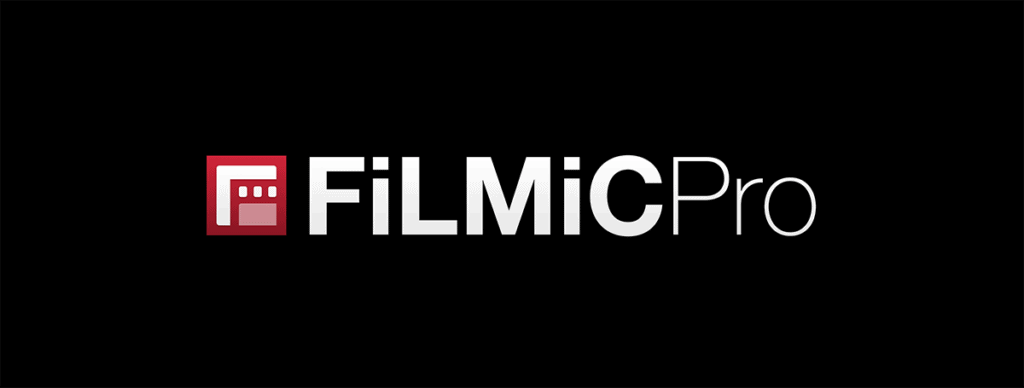
The ZY Play App needs to be used to unlock the full potential of the Zhiyun Smooth 4, so most people end up using this app to record their videos.
Fortunately, the app is one of the better gimbal companion apps. Despite previously having serious issues on Android, many of the bigger issues have been resolved.
However many people, including myself, simply don’t like using the gimbal companion apps to film video. Let’s be honest, they’re simply not the best around, and we’re prepared to sacrifice the some gimbal functions to use better shooting software.
Fortunately, Zhiyun has partnered with the guys over at FiLMiC to give the Zhiyun Smooth 4 native support for the FiLMiC Pro app. This is a fantastic third-party app that you actually want to use and now you can adjust settings using the Zhiyun Smooth 4’s own controls.
Performance
The Zhiyun Smooth 4 provided great all-around image stabilization that lives up to its name. Whether walking or running, the camera shake was completely eliminated. Its stabilization quality was definitely on par with the DJI Osmo Mobile 2.
The motors were very responsive, and activating the “PhoneGo” mode can make them even snappier at times you want to emphasise speed in your films.
Battery Life
The Zhiyun Smooth 4 features built in lithium ion batteries which can record for up to 12 hours.
That puts it among the top gimbals for battery life, and most people won’t have to worry about the batteries being an issue.
It’s slightly disappointing that despite its excellent battery, the Zhiyun Smooth 4 can’t double up to function as a portable powerbank—unlike some other gimbals.
Filming with the Zhiyun Smooth 4
It’s easy to shoot in both portrait and landscape modes, meaning those Instagram stars wanting to directly upload video to the platform will have no problems.
I also found myself using the bundled tripod accessory to function as an extension for the handgrip. By doing so, I had an easy time taking low angle shots, without the need to bend down as I would normally do.
However, I will say that my experience of filming with the Zhiyun Smooth 4 wasn’t quite as pleasant as other acclaimed gimbals, and that was because of the way it felt in my hands.
The Zhiyun Smooth 4 felt a little awkward in the hands for two reasons. Firstly, its ergonomics simply aren’t that good. Second, the sheer number of controls meant I was constantly looking at which button to press rather than focusing my attention to more important matters like how to frame the shot.
Conclusion
Pros
- Good image stabilization
- Highly responsive and quiet motors
- Wide range of video and photo shooting modes
- Ability to change recording settings on the fly using the gimbal’s controls
Cons
- Some functions only work when using the ZY Play app
- Too many controls will be confusing for some
- Ergonomics
Overall, the Zhiyun Smooth 4 is a stunning piece of kit that is a very worthy competitor to the acclaimed DJI Osmo Mobile 2.
Within this price range, the Zhiyun Smooth 4 and DJI Osmo Mobile 2 are definitely the smartphone gimbals to consider.
The Zhiyun Smooth 4 offers more features for the ‘technical’ filmmaker who is constantly adjusting small settings while recording. You no longer need to touch your phone’s screen, since the Zhiyun Smooth 4 has physical controls for that.
However, the Zhiyun Smooth 4’s control scheme felt a little complicated and even excessive. The reality is most people will just want to hit the record button and forget about the gimbal. So for most people, the more compact, ergonomically superior and simpler DJI Osmo Mobile 2 is probably a better bet.
Rating: 4/5
Looking for a gimbal for your iPhone? Check out my list of recommended gimbals for iPhone.
